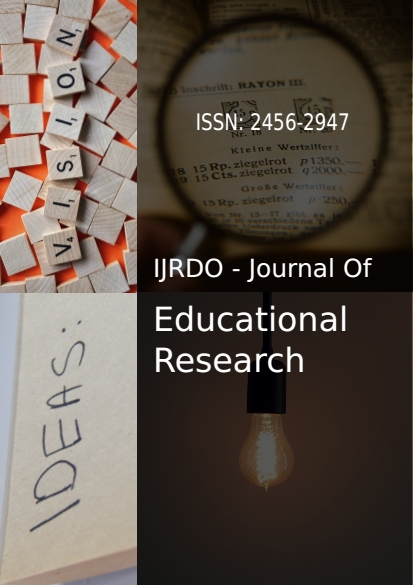Oral and Written Production of Iranian English Learners: Scale of Fluency, Grammatical accuracy, Grammatical complexity and Lexical complexity
Abstract
This study is an attempt to explore fluency, grammatical accuracy, grammatical complexity and lexical complexity among female student teachers of English in West Azerbaijan, Iran. To find out the students four measures in the oral and written productions, we asked the individual participants to write a narrative out of the practical sequence of the story and retell the same story orally after several hours. We repeated this process for three weeks. We obtained and analyzed the data using the formula of fluency, grammatical accuracy, grammatical complexity and lexical complexity. The result showed that the participant’s performance in written form developed progressively. but only in one case it developed regressively. In oral form the development followed different pattern in different cases.
Downloads
References
Bailly, S. &Ciekanski, M. (2006).Learning as identity in practice: The role of the learneradvisor relationship in supported selfdirected learning structure. In Lamb, T.E. and Reinders, H. (Eds.) Supporting independent learning: Issues and interventions. Frankfurt:Peter Lang.
Bley-Vroman, R. 1983. ‘The comparative fallacy in interlanguage studies: The case of systematicity,’ Language Learning 33: 1–17.
Bygate, M. 2001. ‘Effects of task repetition on the structure and control of oral language’ in M. Bygate, P. Skehan and M. Swain (eds):Researching Pedagogic Tasks. Harlow: Longman.
Cook, V. 2002. Portraits of the L2 user. Clevedon: Multilingual Matters.
Fischer, K. and Z. Yan. 2002. ‘Darwin’s construction of the theory of evolution: Microdevelopment and explanations of variation and change in species’ in N. Granott and J. Parziale (eds): Microdevelopment: Transition Processes in Learning and Development. Cambridge:Cambridge University Press.
Fischer, K., Z. Yan, and J. Stewart. 2003. ‘Adult cognitive development: Dynamics in the developmental web’ in J. Valsiner and K.J. Conolly (eds): Handbook of Developmental Psychology. London: Sage.
Lantolf, J. (ed.) 1994. Sociocultural theory and second language learning [Special issue]. The Modern Language Journal 78(4).
Lantolf, J. and M. Poehner. 2004. ‘Dynamic assessment in the language classroom,’ CALPER Professional development Document (CPDD) 0411.
Larsen-Freeman, D. 1976. ‘An explanation for the morpheme acquisition order of second language acquisition,’ Language Learning 26: 125–34.
Larsen-Freeman, D. 1985. ‘State of the art on input in second language acquisition’ in S. Gass and C. Madden (eds): Input in Second Language Acquisition. Rowley, MA: Newbury House.
Larsen-Freeman, D. 1997. ‘Chaos/complexity science and second language acquisition,’ Applied Linguistics 18: 141–65.
Larsen-Freeman, D. 2002. ‘Language acquisition and language use from a chaos/complexity theory perspective’ in C. Kramsch (ed.): Language Acquisition and Language Socialization. London: Continuum.
Larsen-Freeman, D. 2003. Teaching Language: From Grammar to Grammaring. Boston: Heinle/ Thomson. Larsen-Freeman, D. 2005. ‘Second language acquisition and the issue of fossilization: There is no end, and there is no state’ in Z.-H. Han and T. Odlin (eds): Studies of Fossilization in Second Language Acquisition. Clevedon: Multilingual Matters.
Larsen-Freeman, D. and L. Cameron. Forthcoming. Complex Systems and Applied Linguistics. Oxford: Oxford University Press. Larsen-Freeman, D. and V. Strom. 1977. ‘The construction of a second language acquisition index of development,’ Language Learning 27: 123–34.
MacWhinney, B. 1999. ‘The emergence of language from embodiment’ in B. MacWhinney (ed.): The Emergence of Language. Mahwah, NJ.
Pienemann, M. 1998. Language Processing and Second Language Development. Amsterdam/ Philadelphia: John Benjamins Publishing Company.
Selinker, L. 1972. ‘Interlanguage,’ International Review of Applied Linguistics 10: 209–31.
Van Lier, L. 2004. The Ecology and Semiotics of Language Learning. Dordrecht: Kluwer Academic Publishers. Retrieved from http://wikipedia.com
Retrieved from http://longman Dictionary.com
Retrieved from http://webster Dictionary.com
Copyright (c) 2020 IJRDO - Journal of Educational Research (ISSN: 2456-2947)

This work is licensed under a Creative Commons Attribution-NonCommercial-NoDerivatives 4.0 International License.
Author(s) and co-author(s) jointly and severally represent and warrant that the Article is original with the author(s) and does not infringe any copyright or violate any other right of any third parties, and that the Article has not been published elsewhere. Author(s) agree to the terms that the IJRDO Journal will have the full right to remove the published article on any misconduct found in the published article.



